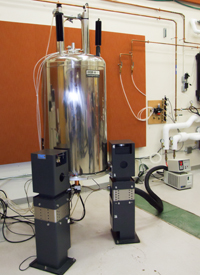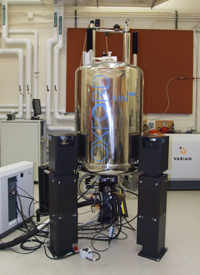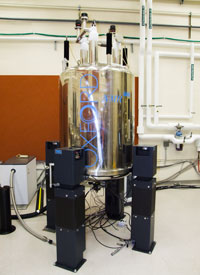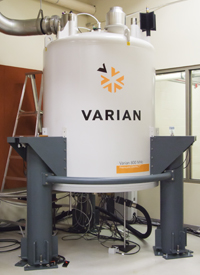400 Instrument
This is largely dedicated to walk-up access for chemists and for pulse sequence development.
There are two probes for the system:
- 5 mm broad-band probe capable of detecting from 15N to 31P (including 13C) along with 1H and 19F. The probe has a wide temperature range, although it is currently equipped for -20 to 200 deg C.
- 5 mm room temperature HCN inverse probe with z-axis gradients. This probe is needed for biological samples and will give superior 1H sensitivity over the broad-band probe. The direct detection of 15N or 13C is not feasible with this probe except with extremely high sample concentrations.
The 400 MHz instrument is typically configured with the broad-band probe. A probe change takes around 2-4 hours. Inquire with the facility manager if a probe change is required.

500 MHz and 600 MHz NMR Instruments
These systems are largely dedicated to long-term biological samples, but may be used for short-term experiments as well.
The 500 MHz and 600 MHz NMR instruments have the following probes:
- 500 and 600: 5 mm HCN inverse cold probes with z-axis gradients. The cold probes are ideal for biological samples when sensitivity is needed. These probes cannot be used for the direct detection of 15N or 13C. The sensitivity of experiments carried out on the cold probes is decreased with increasing ionic strength, thus low salt concentrations are desirable.
- 500 and 600: 5 mm room temperature HCN inverse probe with z-axis gradients. This probe is designed for biological samples and will give superior 1H sensitivity over the broad-band probe, but lower than the cold probe. The direct detection of 15N or 13C is not feasible with this probe except with extremely high sample concentrations.
- 500: 10 mm broad-band probe. This probe is ideal for detecting 15N, 13C, 31P and other nuclei when sample concentrations are limited, but sample volumes are plentiful. In general, the broad-band probe on the 400 will be sufficient for most experiments.
Typically the 500 and 600 MHz instruments are equipped with the HCN cold probes. Swapping a cold probe is a 2-3 day exercise. Thus, probe changes are typically not performed for short-term runs.


800 MHz NMR Instrument
This system is largely dedicated to long-term biological samples.
The 800 MHz NMR instrument has the following probes:
- 5 mm HCN salt-tolerant inverse cold probe with z-axis gradients. This probe is ideal for biological samples. The sensitivity of experiments carried out on the cold probes is decreased with increasing ionic strength, thus low salt concentrations are desirable. However, for samples with ionic strengths greater than 125 mM greater sensitivity can be achieved by using dual 2.5 mm NMR tubes. This probe also is designed for optimum 13C detection and can thus be used for performing 1D 13C experiments for samples where the 400 broad-band probe in insufficient or for 13C direct detection for biological samples. Talk with the facility manager before performing any 13C detection experiments as there are probe safety concerns that must be addressed.
- 5 mm room temperature HCN inverse probe with z-axis gradients. This probe is designed for biological samples. The direct detection of 15N or 13C is not feasible with this probe.
The 800 MHz instrument is typically configured with the HCN cold probe. Swapping a cold probe for the room temperature probe takes approximately 4 hours. As the cold probe and room temperature probes are almost identical in design (except for the cold part) there is in general no reason to not use the cold probe except for certain 15N relaxation experiments.
